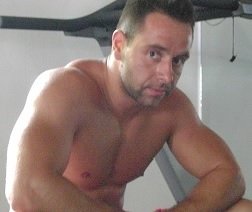How To Build Muscle Mass
If you are wondering how to build muscle mass while not wasting time with useless conventional “wisdom” that mixes pseudoscience with sensationalism, here are 10 tips that may help you to get the results you are looking for.

They should be the bedrock of any successful training campaign that will transform your body and forge your character.
As the old cliché goes, failing to plan properly is planning to fail miserably.
So hopefully this article will make you finally understand why you don't understand what is going on, so you can devise a good strategy and take action.
How to build muscle mass - no bullshit guidelines:
1. Focus on what really matters (no ifs, ands, or buts)
If you are the skinny guy who does countless bicep curls, leg extensions, or peck deck butterflies, it's time to get real. Although you may gain some muscle mass initially, your progress will be insignificant and short-lived.
Bear in mind that none of the top level physiques were built initially with the routines that you see in most fitness magazines. (This is not to say that isolation exercises are useless.)
Take Arnold, for example, whose “rugged foundation” or “core of muscle”, as he plastically explains is his excellent book The Education of a Bodybuilder, was developed exclusively through basic compound exercises that also made him outstandingly strong.
Even Frank Zane, who was the smallest Mr. Olympia ever, is no exception to this rule. In fact, not many people know that he also used to compete in powerlifting, and was pretty strong for his size. (He deadlifted 425 pounds at a bodyweight of 175 in 1968.)
Or Franco Columbu, Arnold's buddy, who in his prime was one of the strongest men on Earth.
There are numerous other examples, but I think you get the point. So stop selling yourself short. If you really want to know how to build muscle mass get accustomed with heavy squatting and deadlifting, and lift some serious weight.
However, bear in mind that there is no single best method for hypertrophy, and one can build a respectable physique even without using any equipment at all.
My point is that light weights should definitely have their place in your program, but if you are still a beginner, fixating on the 80% part of the equation for little results doesn't make much sense.
2. Lift heavy but not too heavy
If your emphasis is on hypertrophy, going way too heavy is not necessary, and perhaps you may not be able to get maximum size when training with very low reps. However, no figure is written in stone, so instead of getting obsessed with a rep number, you should rather focus on progression.
Great results (hypertrophy and strength) were obtained within a wide range (5-12 reps). Arnold's mentor, Reg Park, was famous for using the lowest end of this spectrum, but his case is rather an exception in bodybuilding. And even if Schwarzenegger copied his way of training during the first ten years, he later recommended 8-12 reps.
Probably the most productive program for hypertrophy (but also for gaining tremendous strength) is the 20-rep breathing squat or deadlift with a weight that is normally used for 10 reps.
If your nutrition is adjusted properly (not necessarily drinking gallons of milk as Randall Strossen recommends in his wonderfully written book Super Squats), and take enough rest, you should expect the best results you've ever had. You would definitely know how to build muscle mass :-)
My preference for higher reps is also determined by exercise mechanics. Squatting slightly below parallel (as you always should) will cause a too early concentric failure because you won't be able to return from the sticking point when you go too heavy. So I feel that muscles are not stimulated properly.
3. Train hard but not too hard
As my early bodybuilding education was influenced by Arthur Jones, I was a firm believer that every single exercise should be taken to complete failure.
This seemed the most logical way to train, and the lame metaphor about the futility of flipping a switch on and off once the light is on made complete sense to me.
As many of you know, Jones used to say that “if you have never puked from doing bicep curls, then you don't know what hard training is”. In other words, if you don't punish yourself brutally, you are a lazy bastard who doesn't deserve any gratitude.
Now, besides the fact that there is no need to go 100% to stimulate a muscle, this approach has negative implications from a psychological perspective.
Going to failure is counter productive because your brain interprets it literally...as a failure. And how can one be enthusiastic about failing all the time? Which brings me to the next point...
4. Be conscious but also consistent
If you are wondering how to build muscle mass, the best answer (that you may not like) is simple: by being consistent.
If you always change your workouts according to the last Men's Health magazine, or start training six times a week early in January and give up by February, you will get what you deserve...nothing.
5. Get stronger but also bigger
I was mentioning that most top bodybuilders are very strong. Well, maybe I should also note that Judd Biasiotto squatted 575 pounds at just 131 bodyweight while many of today's 300 pound behemoths struggle with much less than that.
So strength doesn't always correlate with size, and the answer to "how to build muscle mass" is not consistently found in raw power.
Now, besides the genetic heritage or/and enhancement with drugs, this is also due to differences in the training approach. Hypertrophy specific training (higher reps and briefer rests between sets) concerns not only the contractile elements of the muscle tissue but also the myofibrils, sarcoplasm (plasm within the cell) and mitochondria.
6. Train less but also more
This apparent nonsense is not meant to imply that “less is more” (as HIT aficionados like to preach) because less is not more if is not enough. According to your level of training or recuperation capacity, you should limit your training to three times a week but focus solely on the big exercises.
In other words, your body will get stimulated on a greater scale while keeping a fairly low frequency to avoid the plague of overtraining.
Although you may be skeptic about squatting or deadlifting three times a week, keep in mind that you will not attempt to increase the weight every single workout for all exercises. On the contrary, don't be ashamed to decrease the weight whenever you get stuck in inevitable plateaus.
The progress doesn't have to be (and won't be) linear. But it doesn't matter as long as a more vigorous momentum is created.
7. Eat a lot but not too much
“If you want to get high definition and keep it for the rest of your life then don't bulk up. It's really best to not gain more than 5% over your best looking bodyweight and train at that weight.” (Frank Zane's High Def Handbook, 2008)
Truth be told, most neophyte bodybuilders are wondering “how to build muscle mass” just to find a pretext to pig out on junk food all day long. So how do you know when enough is enough? Simple.
You should always be able to see your upper abs in the mirror. If your abs are wonderful but completely missing, then take it easy with the chocolate cookies.
8. Imagine but be also realistic
Having a clear target to shoot for is vital, no matter what your objectives are. When it comes to visualizing your future physique, it helps to have high standards as long as you are realistic.
So think about a role model with a body structure similar to yours, and who is training under the same circumstances. Arnold's model, for example, was Reg Park, and he couldn't have chosen better because their bodies were almost identical.
It's also important to understand that natural bodybuilders (like you or me) should be aware of their muscular potential to avoid frustration or disappointment. Casey Butt made an extensive research on this subject, so if you take a look at his booklet, you will surely know the difference between doable and foolish.
9. Read but filter the information
If you are passionate about fitness stuff, read as much as you can, but don't believe everything you read because most of the information is based on nonsensical fiction. As you know, there are numerous muscle building programs available, and all claim to be the best.
How is that possible? Well, it's possible because the unbiased research on how to build muscle mass is very scarce, and the whole subject is still poorly understood.
10. Know what you need (or what you think you need) but don't get dogmatic
I used to be a firm believer in the HIT philosophy, dismissing abruptly any other school of thought. This was a gross deception because I stubbornly went through the whole trial process and wasted about 2 years to eventually realize that this way of training doesn't work. Don't make the same or a similar mistake...
So these, my friend, are 10 important pieces of advice that should help you to figure out how to build muscle mass and achieve your full potential as efficiently as possible.
And always remember: “energy is correctly used not by spending it to hold ourselves inactive, nor by spurring ourselves to unproductive, sterile activity, but only when it is at the service of the maturest and most comprehensive idea of ourselves that we can arrive at”. (Dorothea Brande, Wake up and live!, 1936.)
Return from How To Build Muscle Mass to Home





